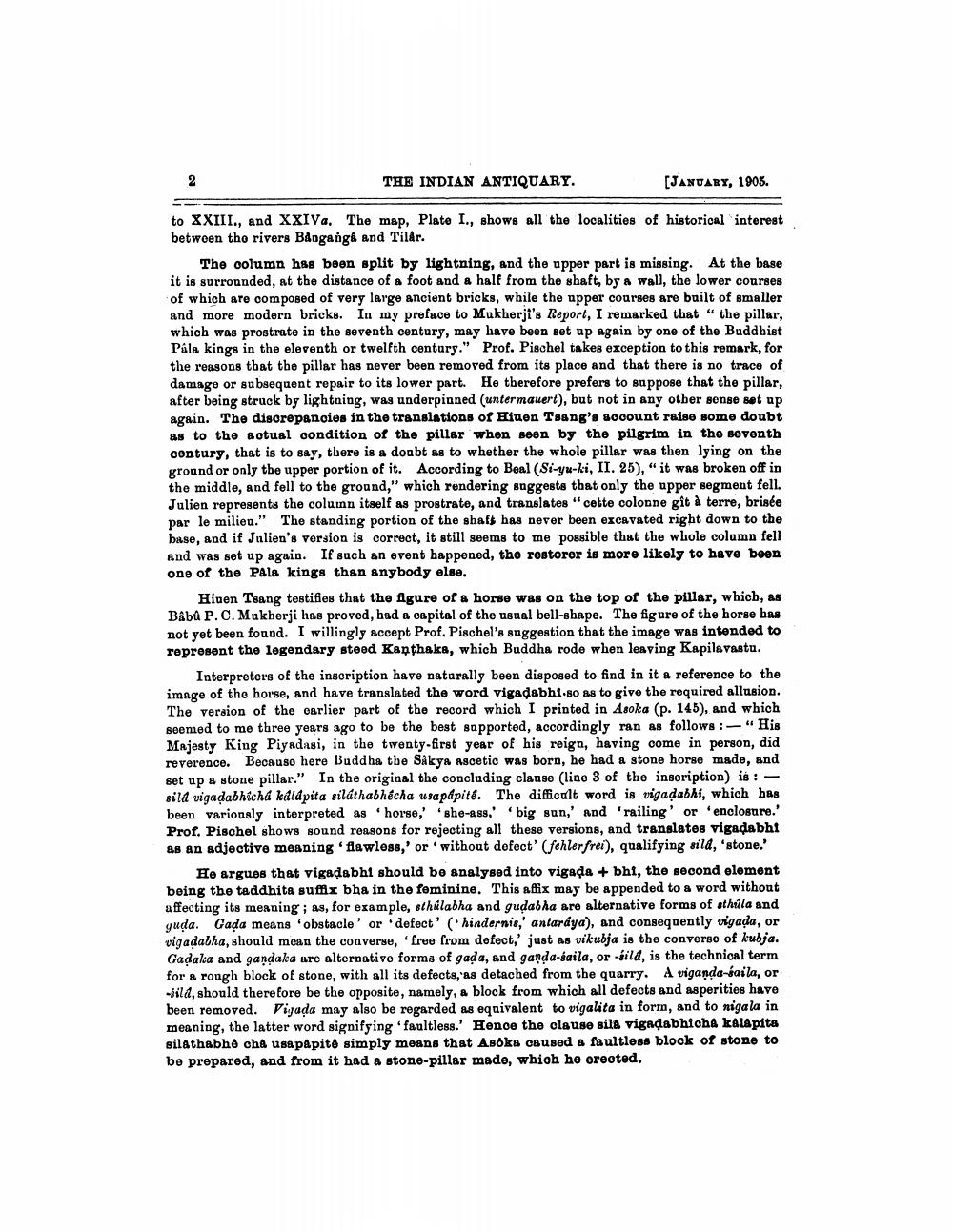Book Title: Indian Antiquary Vol 34 Author(s): Richard Carnac Temple Publisher: Swati Publications View full book textPage 8
________________ THE INDIAN ANTIQUARY. [JANUARY, 1905. to XXIII., and XXIVa. The map, Plate I., shows all the localities of historical interest between tho rivers Banganga and Tildr. The column has been split by lightning, and the upper part is missing. At the base it is surrounded, at the distance of a foot and a half from the shaft, by a wall, the lower courses of which are composed of very large ancient bricks, while the upper courses are built of smaller and more modern bricks. In my preface to Mukherji's Report, I remarked that “the pillar, which was prostrate in the seventh century, may have been set up again by one of the Buddhist Pála kings in the eleventh or twelfth century." Prof. Pischel takes exception to this remark, for the reasons that the pillar has never been removed from its place and that there is no trace of damage or subsequent repair to its lower part. He therefore prefers to suppose that the pillar, after being struck by lightning, was underpinned (untermauert), but not in any other sense set up again. The discrepancies in the translations of Hiuen Tsang's account raiso some doubt as to the sotusl condition of the piller when seen by the pilgrim in the seventh century, that is to say, there is a doubt as to whether the whole pillar was then lying on the ground or only the upper portion of it. According to Beal (Si-yu-ki, II. 25), “it was broken off in the middle, and fell to the ground," which rendering suggests that only the upper segment fell. Julien represents the column itself as prostrate, and translates "cette colonne git à terre, brisée par le milieu." The standing portion of the shaft has never been excavated right down to the base, and if Julien's version is correct, it still seems to me possible that the whole column fell and was set up again. If such an event happened, the restorer is more likely to have been one of the Pala kings than anybody else. Hinen Tsang testifies that the figure of a horse was on the top of the pillar, which, as Baba P. O. Mukherji has proved, had a capital of the usual bell-shape. The figure of the horse bas not yet been found. I willingly accept Prof. Pischel's suggestion that the image was intended to represent the legendary steed Kanthaka, which Buddha rode when leaving Kapilavastu. Interpreters of the inscription have natarally been disposed to find in it a reference to the image of the horse, and have translated the word vigadabhi.so as to give the required allusion. The version of the earlier part of the record which I printed in Asoka (p. 145), and which seemed to me three years ago to be the best sapported, accordingly ran as follows:- "His Majesty King Piyadasi, in the twenty-first year of his reign, having come in person, did reverence. BecauSo here Buddha tbe Sakya Ascetic was born, he had a stone horse made, and set up a stone pillar." In the original the concluding clause (line 3 of the inscription) is :sild vigadabhicha kdlápita siláthabhécha usapápite. The difficult word is vigadabhi, which has been variously interpreted as "horse,' she-ass, big sun,' and 'railing' or 'enclosure.' Prof. Pisohel shows sound reasons for rejecting all these versions, and translatos vigadabhi as an adjective meaning 'flawloss,' or 'without defect' (fehlerfrei), qualifying sild, 'stone.' He argues that vigadabhi should be analysed into vigada + bht, the second element being the taddhita sufx bha in the feminine. This affix may be appended to a word without affecting its meaning; as, for example, sthilabha and gudabha are alternative forms of sthila and guda. Gada means 'obstacle' or 'defect' (hindernis,' anlardya), and consequently vigada, or vigadabha, should mean the converse, 'free from defect,' just as vikubja is the converse of kubja. Gadaka and gandaka are alternative forms of gada, and ganda-gaila, or-sild, is the technical term for a rough block of stone, with all its defects, as detached from the quarry. A viganda-baila, or -sild, should therefore be the opposite, namely, a block from which all defects and asperities have been removed. Viyada may also be regarded as equivalent to vigalita in form, and to nigala in meaning, the latter word signifying faultless. Hence the clause silA vigadabhtoha kalapita BilAthabho cha usapapito simply means that Asoka caused a faultloss block of stone to be prepared, and from it had a stone-pillar made, whioh he erooted,Page Navigation
1 ... 6 7 8 9 10 11 12 13 14 15 16 17 18 19 20 21 22 23 24 25 26 27 28 29 30 31 32 33 34 35 36 37 38 39 40 41 42 43 44 45 46 47 48 49 50 51 52 53 54 55 56 57 58 59 60 61 62 63 64 65 66 67 68 69 70 71 72 73 74 75 76 77 78 79 80 81 82 ... 548
